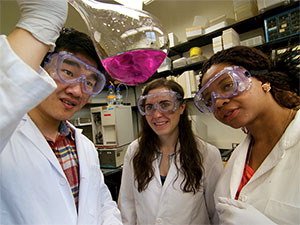Dow + U = lab safety

A new safety campaign for laboratories takes hold
They say you can never be too careful. At the University of Minnesota, that goes double.
Through a unique partnership with the Dow Chemical Co., graduate students and postdoctoral researchers from the U departments of Chemistry and Chemical Engineering and Materials Science (CEMS) are leading a campaign to improve and sustain the safety culture in chemistry and chemical engineering laboratories.
While Dow is not providing a financial donation for the initiative, it is sharing its best-in-class laboratory safety practices, examples, advice, and resources. Last spring Dow sponsored a two-day safety training for students and faculty at its facility in Michigan, and it has been providing advice to the students and postdocs since.
The safety partnership could help other universities across the country, as well.
"Dow's leadership in assisting universities to strengthen their commitment to safety will yield long-lasting benefits to the academic enterprise nationwide," says Frank Bates, head of CEMS.
"Dow's leadership in assisting universities to strengthen their commitment to safety will yield long-lasting benefits to the academic enterprise nationwide."
"The fact that it is being led by the graduate students and postdoctoral researchers is terrific," says William Tolman, chair of the chemistry department. "Their energy and creative ideas are already having a profound impact."
Joint Safety Team
Graduate students and postdocs in the two departments have formed a Joint Safety Team (JST), comprising 62 laboratory safety officers (LSOs) and interested graduate students from the two departments. The JST's safety campaign focuses on improvement in four areas, summarized "CARE": compliance, awareness, resources, and education.
The JST has compiled a "guidebook" of recommendations for improving safety practices. Short-term items implemented this fall include posting new laboratory signs that emphasize personal protection equipment (PPE) requirements, potential hazards in the lab, and guidelines on how to make the labs safer places to conduct research.
Kathryn McGarry, chemistry graduate student and chair of the JST Administrative Committee, notes four successful events so far:
- The first round of LSO-led laboratory walkthroughs in November and December gave each principal investigator and 51 LSOs a report on how their labs performed, and the LSOs saw the safety concerns in other labs.
- In January the first Cleanup Week, held in collaboration with the Department of Environmental Health and Safety (DEHS) for the chemistry department and CEMS, resulted in the safe disposal of 321 samples of unknown waste, saving thousands of dollars and improving safety in the labs.
- A new website (www.jst.umn.edu) provides JST and safety related information to researchers and LSOs.
- The first LSO training session, held January 16, attracted 51 of 52 LSOs.
Sharing the wealth of information
Also, McGarry says, "safety moments" at the beginning of seminars are becoming popular and spreading.
"I heard from a University of St. Thomas professor that Professor [Thomas] Hoye included a safety moment in his recent visit to UST," she says. "The focus was on the chemical trimethylsilyl-diazomethane and the necessary safety precautions when working with this compound."
"The peer lab audits have been especially helpful," says doctoral candidate Nick Erickson, a former LSO from a CEMS lab and former member of the JST Administrative Committee. "Personally, this has given me the chance to see how solid hazardous waste is handled in other labs, and we've used that knowledge to improve our labs. [Also], having standard signage has greatly improved the use of personal protective equipment in labs. Having the hazards listed on the door of each lab, and how to safely avoid them, is a constant reminder to wear the proper safety equipment in each situation."
"The Department of Environmental Health and Safety is committed to learning from this innovative program and sharing what we have learned from this experience with others across the campus."
"The Department of Environmental Health and Safety is committed to learning from this innovative program and sharing what we have learned from this experience with others across the campus," says Craig Moody, director of the DEHS. "The students involved in this program should be very proud in knowing they will have an impact on the health and safety of thousands of students and staff in the years to come."
-Adapted from a September 2012 article by the Department of Chemistry
